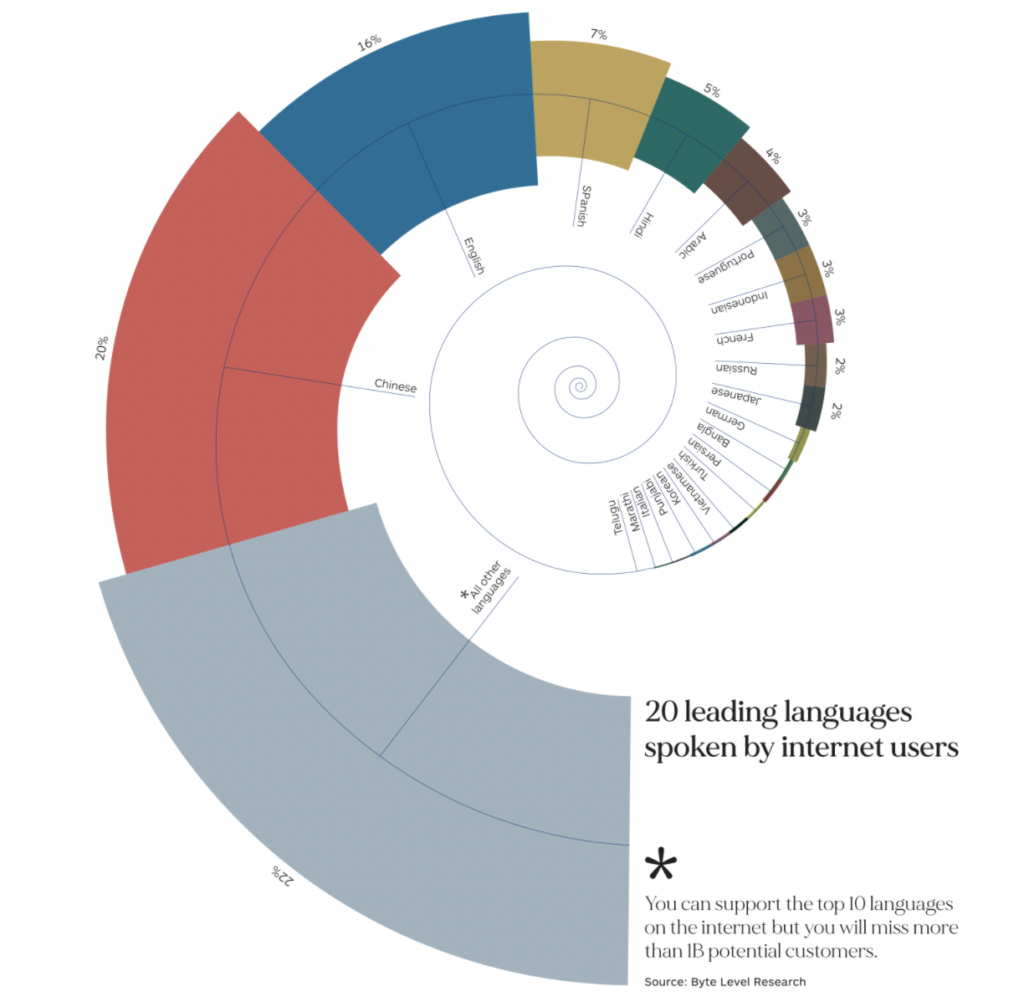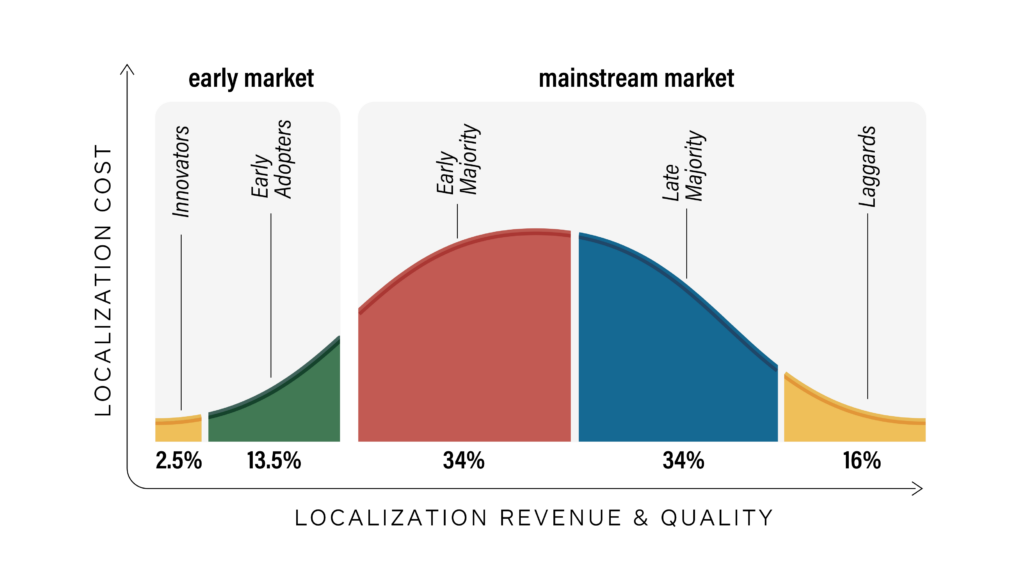Localization
It’s one of the most widely used words in the world of business, but what does “localization” really mean? And what do localization teams actually do? In this exclusive article for Imminent, Airbnb’s Head of Localization Salvatore Giammarresi clarifies what the localization wor(l)d entails.
Localization in the 21st century
As the world becomes smaller, flatter and more connected —and as more companies follow the lead of more pioneering and forward-leaning global businesses — the 21st century will see an increased demand for localization professionals, services and expertise. Localization professionals and the whole industry need to prepare for this new focus and responsibility, starting from a common understanding of what localization is.
Still today, it’s not uncommon for people in and out of the localization industry to use the terms translation and localization interchangeably, almost as synonyms. While everyone in the localization industry understands that they are two very different things, many professionals outside this sector usually don’t know the difference. We will explore the differences and relationship between translation and localization. It’s important that we create and reinforce a shared language among professionals inside and outside the localization industry, as it will help everyone better fulfill the business growth goals of their companies— along with supporting the evolution and maturity of the localization industry as a whole.
Explaining the changing nature of localization
Probably one of the most commonly shared experiences among localization professionals, at multiple times in their career, is succinctly explaining what localization is and therefore what the localization team does.
We have all been there. Maybe you have to present your team to your new manager; or explain what the team does to a new executive; or why it needs the partnership of another team.
Obviously, you know what your team does, but you still might decide to do a quick search online to see if someone else in the industry has come up with a better definition that you can quickly borrow.

oXXIgen
Imminent Research Report 2022
GET INSPIRED with articles, research reports and country insights – created by our multicultural interdisciplinary community of experts with the common desire to look to the future.
Get your copy nowUsually, you would find pretty standard definitions of the word translation, but as you look up the words localization, internationalization, globalization and transcreation, you sense more and more that there are no standard canonical definitions, and none of the definitions seem to truly capture the essence of what localization is all about.
Facing a similar dilemma, Nataly Kelly proposed in her 2020 blog post, “Creating a more accessible localization definition”, “rebranding” localization with a one-word definition: Experience. She also offered one sentence to explain what localization success means: Our customer experience delights in other markets.
We should admire Nataly’s rebranding exercise and I hope that, as an industry, we land on a more canonical definition.
The irony is that — because a big part of what localization professionals do is to adapt a given piece of content to a specific audience— we usually change our definition so that it has the proper effect on our audience given their own (and the company’s overall) level of maturity in this subject.
The worst mistake most of us have made, especially in the earlier stages of our careers, is to confuse “what” we do with “how” we do it, and many times omit the “why” we localize. Many definitions you find online make the same rookie mistake.
It’s not uncommon in our industry to find people who can explain in great detail the inner workings of their localization processes and tools but then are not as confident in explaining how localization is helping to grow business or what is within the scope of localization teams.
To make matters worse, our definitions might vary based on where the localization team reports into the larger company organization structure. So, for example, if the team reports within Engineering, they might over-emphasize the engineering aspects of their contributions, and omit or de-emphasize the business or product impact of their work, maybe because in that specific company those are out of scope for the Engineering organization.
Bottom line is that, if you are like me, you might have been dissatisfied with the definitions you found online, and you have created and collected a list of your own definitions. Each of them might have helped in that specific company, presentation or document, but left you still not fully convinced that it properly explained the core truth of what you and your team really do.
The damaging effect all this has, that I have personally experienced throughout my career, is that for people outside the localization industry, it really isn’t clear what we do, and therefore they have a hard time understanding how they can best partner with the localization team toward common goals. This lack of clarity sometimes, and in part, explains why localization professionals are left out of key conversations, and get pulled in usually too late in the product development lifecycle.
All this becomes even more evident when you work with peers outside our industry that have worked at multiple companies, and therefore have been exposed to many different definitions and types of localization.
The net outcome of all this is that, at best, our non-localization professionals understand what translation is, and therefore think that all we do is to translate. Beyond that, our peers are confused and keep asking us “what does the localization team do?”.


Explaining the core of localization
Despite all the various definitions you can find online, it’s hard to find a great localization definition that resonates and that can truly help educate non-localization professionals.
As I’ve progressed in my career, I’ve created and used a variety of my own definitions of localization. While these definitions might have helped me in a specific presentation, I’ve usually felt they fell short of properly and succinctly explaining the core essence of why, what and how we localize.
Below is the latest iteration of the definition I’ve been using lately, which is primarily tailored for non-localization professionals, with the goal of educating them so that we can better partner. This is critical as most of the bigger impact work localization teams do is cross-functional and requires clear alignment and partnership with our peers.
LOCALIZATION
is the practice of growing a global audience by adapting a product experience, so that it is linguistically-relevant, culturally-appropriate, legally-compliant, and globally-scalable, from a source locale into one or more target locales.
TRANSLATION
is the practice of conveying the same meaning of a written text from a source language into one or more target languages.
From Language to Locale
One of the implications from these two definitions is that, by and large, translation is focused on languages, namely a source language and one or more target languages.Localization, on the other hand, because it is applied to products or “experiences”, and as it takes into account cultural, legal and scalability considerations, is more nuanced and focuses on locales, again source and target. A locale identifies a specific audience that shares a language plus other so called “locale-specific” standards, cultural norms, laws and regulations. For this reason, in its most basic form, a locale identifies people who share a language and live in the same country or region, where it is safe to assume that everyone (or the majority of people) shares the same culture, laws, standards, tax rules, banking regulations, etc. Obviously, the concept of locale is not perfect and it doesn’t account for all the possible variations that might exist within the same linguistic community in a country or region. This is particularly true in the context of contested territories.
The implications of Localization
Let’s try to better understand what it truly means to localize by unpacking the definition I offered above by going deeper on some key words contained in the definition.
Growing a global audience
The reason we localize a product or a service is to grow a company’s audience and therefore its business. Depending on the stage and type of company, this growth can be measured in revenue, users, visitors, clicks, market share, downloads, etc. It’s important to remember this and it’s important that localization professionals put that front and center in their annual goals and KPIs. This will help them find common ground with their peers and be heard by the leaders in their companies.
This focus on growth, and the very growth of the localization profession and the industry as a whole, is based on a few consolidated trends that have been true since the advent and widespread use of the world wide web starting in 1990.
As more people have joined the web, the audience on the web has increasingly reflected and mirrored the linguistic and cultural diversity that has always existed in the real world.
In the mid 90s, most of the users on the web used English as their primary language. Fast forward to 2021, and the largest segment of users online is made up of people who use a language other than one of the top 20 languages online. Chinese speakers are the second largest segment online, English is the third, followed by 18 other languages that have a decreasing share of users.


A second data point— further validating this trend— is that every day on average nearly 1 million people join the internet for the first time, and only 9 out of 100 new internet users rely on English as their primary language.
The third data point is that only half of the world’s population is online. Therefore, all these trends are only going to continue and expand in the 21st century.
This is why companies localize their products and services. This is why localization professionals and teams exist, to help companies reach this ever growing linguistically and culturally diverse audience.
The web allows any business to instantly be available to everyone online, however every day there is a vast and growing audience of potential users who might not be able to interact with that business because it doesn’t properly support their language, let alone their culture and their locale-specific standards.
“Every day on average nearly 1M people join the internet for the first time, and only 9 out of 100 rely on English as their primary language.”
An obvious example of how localization teams can grow their company’s global audience is by adding more supported locales. This is what Airbnb did in 2019, when it more than doubled the number of locales it supported.
Product experience
A digital product often is a whole experience made of the sum of many components. It’s not uncommon that a “product” is made of a main web landing page, that is linked to many more pages (or product flows), including the company’s homepage, a sign-up page, a configuration and a checkout flow, just to name a few, and these pages then might link to help articles or videos. The product might be tied to an email campaign that drives potential users to the landing page. The customer support (whether via email, sms and/or phone) available for a product is also part of the experience. Similarly, there might be a marketing campaign, made of different assets on a company’s site and on social media. Digital experiences also exist on different platforms; therefore, the same product might have a version for web, an app for mobile, one for tablets and maybe one for your digitally enabled TV or car.
Localization professionals, in partnership with other stakeholders, need to determine the appropriate localization strategy for each product experience. Part of this strategy is determining the depth of localization and the acceptable quality standards for each product experience in each locale in order to grow the business, while being agile and cost efficient. In an ideal world, all components would be localized, but in the real world, based on budget, timing and resources, companies need to determine what is enough to win and then iterate.
In his famous book Crossing the Chasm, Geoffrey Moore reminds us that “as your product evolves, your customer base evolves, your product strategy evolves”.
Similarly, I would add, your localization strategy must evolve as your company, your product and your audience evolve.
In general, early-adopters and users with fewer choices will tolerate a lower depth of localization as well as, on average, lower localization quality.
On the other hand, the late-majority users, and in general users in highly competitive markets, where there is a higher degree of customer choice and expectations, growing a company’s audience and business often implies providing more nuanced depth of localization and increasing levels of quality of localized products.


Localization professionals play another key role in their respective companies: as they support all teams and functions, they are often one of the first teams, if not the only, to detect inconsistencies across all the components that make the final end-to-end experience.
This means ensuring consistency of terminology, voice, tone, style, value propositions, taglines, icons, colors, etc.
The reason for this is that localization professionals, in order to properly localize, must go deeper in each component and often ask questions that were not asked previously. They naturally connect dots that were not properly connected before. This is particularly true when a new product uses existing or legacy components plus newly made components.
“Localization professionals naturally connect dots that were not properly connected before.”
This is also the reason why centralized localization teams are much more valuable to companies compared to decentralized ones, as they help combat the natural tendency within companies of teams working in silos, even though they are all building components and product flows that are part of the whole product. By asking the right questions earlier in the product development lifecycle, localization professionals help companies launch better products in all locales, including the source locale.
Linguistically-relevant
To be linguistically-relevant a product obviously needs to be in the user’s language, therefore the written text should be translated. This is usually considered a minimum bar. This is why we say that translation is a part of the localization process.
In the case of products that rely heavily on spoken language (like videos and movies), being linguistically-relevant also means that the spoken language is dubbed and/or the subtitles are transcribed, translated and captioned in all the target languages.
The more languages a company supports, the more opportunities it has to offer a linguistically-relevant product experience to its users.
This is the reason why, as the web becomes ever more linguistically diverse, more companies add additional language support.
In 2019, Airbnb, in partnership with Translated, added 33 new languages (with an asterisk below), for a total of 62, covering more than 82 locales. This, at the time, was one of the single largest language expansion projects in the localization industry. It allowed Airbnb to reach an additional 1 billion people in their native language.
| Albanian* | Franch (France) | Portuguese (Brazil) |
| Arabic* | Georgian* | Portuguese (Portugal) |
| Armenian* | German | Romanian* |
| Azeri* | Greek | Russian |
| Bosnian* | Hebrew* | Serbian* |
| Bulgarian* | Hindi* | Slovak* |
| Catalan | Hungarian | Slovenian* |
| Chinese (Hong Kong*) | Icelandic | Spanish (Argentina)* |
| Chinese (Simplified) | Indonesian | Spanish (LATAM)* |
| Chinese (Taiwan) | Irish* | Spanish (Mexico) |
| Croatian | Italian | Spanish (Spain) |
| Czech | Japanese | Swahili* |
| Danish | Korean | Swedish |
| Dutch | Latvian* | Tagalog* |
| English (Australia)* | Lithuanian* | Thai |
| English (Canada)* | Macedonian* | Turkish |
| English (UK)* | Malay | Ukrainian* |
| English (US) | Maltese* | Vietnamese* |
| Estonian* | Montenegrin* | Xhosa* |
| Finnish | Norwegian | Zulu* |
| French (Canada)* | Polish |
While translation is necessary (if the product contains written text) it is often not sufficient.
Language is pervasive and embedded in many elements of a product and how users engage with a product. Therefore, it’s not always obvious what linguistic relevance means for a company, until you actually localize a specific product.
To start with, in order to translate, we need to know the language of the user.
In the case of many companies that are starting their localization journey, the localization team must influence changes in the product and in the code in order to detect the language of the user, so that the most relevant translation can be displayed.
This is one example where the localization practice departs from being purely a linguistic practice and intermingles with Engineering, Design, UI, UX and Legal considerations.
Being linguistically-relevant also means that sometimes a straight translation is not the answer and instead a company must fundamentally change the tone, voice, style, wording, etc. of a written text in one or more target locales. This happens often in product names, taglines, value proposition statements, marketing pages and campaigns. The marketing team worked hard to find the catchy tagline, or the perfect product name, however they just don’t translate at all or they don’t translate well. In these cases, being linguistically-relevant means that the localization team, in partnership with other stakeholders, must find the most appropriate product name, tagline, etc. This process is often called transcreation. Depending on the type of product, this highly creative step can entail fundamental changes to the product, so that it’s even more linguistically-relevant and culturally-appropriate.
In order for the whole experience of the product to be linguistically-relevant, localization teams sometimes also need to get into the details of how other teams operate. For example, in order to properly localize text within images, localization teams require the design team to provide layered image files, so that the text can be changed easily and independently from the images.
Another example of being linguistically-relevant is the best practice of replacing all source screenshots of the product, with the equivalent localized screenshots.
Linguistically-relevant implies that the product design adapts appropriately as the language changes.”
Linguistically-relevant implies that the product design adapts appropriately as the language changes. When Airbnb launched Airbnb Plus, one of the design signatures of the product was to underline the word of a city in sentences like “Home in Los Angeles”. (1)
In English it looked beautiful. However, it didn’t work in some languages, like Japanese and Korean, where the word indicating the location comes first in the sentence. Since the design was “tailored” for the US English use case, its logic was to underline the words on the second line of text, where in English you always had the name of the city. The final result, in Japanese and Korean (2), was that the words being underlined were “Homes in” and sometimes with bizarre effects. In this case we solved it with a new design (3) that was not impacted by linguistic differences.


Another example is ensuring text is not truncated for some languages that might need more room, like in this example in Hungarian (Fig.2).


Fig. 2: Hungarian text needs more room.
Last but not least, linguistically relevancy is particularly challenging when products rely on user generated content, such as home descriptions and reviews, in Airbnb’s case. This is also why, in 2021, Airbnb launched Translation Engine, which, once fully released, will allow Airbnb users to see all content automatically translated in their language, regardless if the content was created by Airbnb or by one of our users.
These few examples show how being linguistically-relevant can be synonymous with translation in the most basic scenarios, but often it means much more. It entails understanding how companies display and manage the written or spoken language that appears across all the components that make up the final whole experience of the product and its product and technical implications across each supported locale.
Culturally-appropriate
Products are often ideated, designed and built with a user or “persona” in mind. Often this “ideal user” reflects what is best known by the majority of people working on that product. This is even more visible when product teams don’t clearly specify a persona. Therefore, teams tend to infuse, often unwittingly, cultural assumptions of their locale into their products. Your product is essentially a mirror of your culture.
Globally mature companies are aware of this and therefore they specify and create products based on locale-specific personas. But even then, it’s possible that only the top-tier country personas are defined, therefore not all cultural elements across all locales are properly captured until the localization process starts in earnest.
Part of the work of a localization professional is to ensure that the cultural assumptions embedded in the product are appropriate for each of the cultures (locales) in which the company is doing business.
And if they are not appropriate, it’s the job of the localization team, again in partnership with all relevant stakeholders, to make product changes to ensure that the users within each locale have the most culturally-appropriate experience with the product or service.
Culture is even more pervasive than language.
Our cultural background comes through not only in our written text, but also in our use of colors, icons, photos, how we present all these elements on a page, our sense of humor, the types of questions we ask our users in our user interfaces, when we ask them, how we refer to seasons, what we consider a “working day” versus a “holiday”, and so on.
When Airbnb announced a major service update in November 2021, in order to be culturally-appropriate, it was called the “Winter Release” across the countries in the northern hemisphere and was called “November Release” in the southern hemisphere.
(Fig. 3).


Fig. 3: Airbnb’s announce of a major service update.
One example of how companies could easily be more culturally-appropriate is to replace the photos showing users from the source locale, with photos that are more representative of their users in each target locale.
At times, linguistic-relevancy and culture-appropriateness intermingle, as was the case of the gendering initiative Airbnb launched in Germany in 2021. Gender-inclusive language has gained more and more support, as German TV, podcasts and some companies started gendering not only in written form but also phonetically. Airbnb’s initiative entailed gendering all nouns referring to people— for example, the word Host, which previously was translated in the masculine form Gastgeber. Now on Airbnb’s German product, we use the gendered form “Gastgeber:in” for singular and “Gastergeber:innen” for plural. Making this change required deep cross-functional partnership and changes to our tools, designs, etc. This is what a portion of the footer on Airbnb’s German site looks like now with singular and plural gendered forms. (Fig. 4).


Fig. 4: A portion of the footer on Airbnb’s German site looks like now with singula and plural gendered forms.
Legally-compliant
Launching a product and doing business in a locale, also means that a product is compliant to all local laws, regulations, standards, etc.
It is the role of the localization team to ensure that a product is broadly legally-compliant. The reason for this is that usually they see all the content and are exposed to the whole product more than the legal team. Obviously, we cannot expect localization professionals to be legal experts, however in partnership with the legal and compliance stakeholders and based on their localization experience, they should play a key role in ensuring that products and businesses don’t fail simply because they are not legally-compliant.
Examples of minimum bar legal-compliance are ensuring a product or service properly displays locale-specific data such as numbers, addresses, phone numbers, dates, calendar, etc.
In addition, the Terms of Service and any legal documentation related to a product or service, obviously need to be properly localized for each supported locale.
An example of how localization can help ensure legal compliance is when reviewing the designs of Airbnb’s AirCover product, we detected that the creative team was using an image of a glass of wine. While it was beautiful and would work in almost any country, we had to change it to a glass of juice for the French market, in order to comply with the local Loi Evin, which highly regulates alcohol marketing and largely bans the depiction of alcohol in advertising in France (Fig.5).


Fig. 5: For the AirCover product the Airbnb creative team used
an image of a glass of wine, but it did not work for the French market where is in force the “Loi Evin”
Globally-scalable
Because the goal is to reach the largest audience, localization professionals always try to set up and optimize their programs and operations for global scale and impact.
This global scale mindset is what has allowed Airbnb’s relatively small localization team to simultaneously launch all our products in 29 languages until 2019 and then 62 languages afterwards, without having to fundamentally change processes, team structure, tools, technology, etc.
Global operational excellence is a key characteristic of great localization professionals and teams. As localization requirements increase within a company, it requires a high degree of program management and operational mastery to drive all localization projects to completion, on time, within budget, and with the right degree of quality, while partnering with internal cross-functional stakeholders and external ones, like localization vendors.
Being globally-scalable also refers to the ongoing work localization professionals do to automate, streamline and improve the operations of a company’s localization practice across all functions, for example how teams submit content to be localized to the localization team.
In order to deliver localized products with the highest velocity and quality and lowest cost, keeping up with the pace of modern tech companies, localization professionals must come up with the best localization strategy to make their product globally-scalable.
This strategy depends on the type of product, the type of company, its business goals and many other factors.
The outcome of this globally-scalable strategy is an ever-evolving blueprint that outlines the processes, the tools, the technologies, the teams, the automation, the vendor SLAs and many other elements that allow a company to launch simultaneously in all supported locales, with the highest speed and quality and lowest cost.
Last, but not least, globally-scalable processes, tools and technologies is what allows companies to easily reach not only the people online who use one of the top 20 languages, but also the people in the largest “all other languages” segment.


Helping our business partners going forward
In the localization industry we’ve always known that translation is part of the localization practice, if the product that is being localized contains written or spoken language.
This is one of the reasons why localization professionals hardly ever use the term translation instead of localization. Actually, if they work in high tech, they most likely use the term localization more often than not, because they know that most of the time a “simple” translation is not enough.
However, we all know how common it is to work with people outside of the localization industry, who use the two terms interchangeably or actually tend to default to the term translation.
One reason for this is that the term (and practice of) translation is actually pretty well known. It’s an age-old term that has been used since the invention of the written language.
On the other hand, the term localization is a modern term that has been used in earnest for the past 30 years and particularly in and around the high-tech industry, as we have developed and refined more and more digital products.
The other reason though is that, as an industry, we have been feeding inconsistent information to our non-localization peers. Everyone in the localization industry needs to contribute towards a more mature industry, and part of this process is consolidating the use of a shared terminology. This will help strengthen the role of localization professionals as they become even more valuable to companies in the 21st century .
Most of all this will help our non-localization peers better understand how and when to partner with localization professionals and teams, so that together we can achieve common business goals and make our products available and delightful to a larger global audience.



oXXIgen
Imminent Research Report 2022
GET INSPIRED with articles, research reports and country insights – created by our multicultural interdisciplinary community of experts with the common desire to look to the future.
Get your copy nowPhoto credits: Jon Tyson, Unsplash / Wanderlabs, Unsplash / Hello I M NIK , Unsplash
